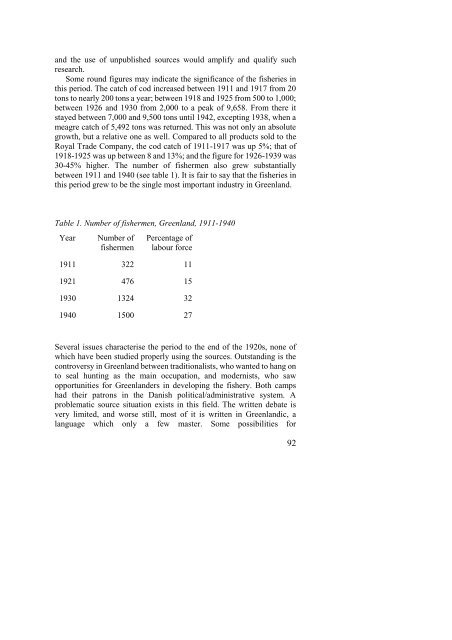The North Atlantic Fisheries, 1100-1976 - University of Hull
The North Atlantic Fisheries, 1100-1976 - University of Hull
The North Atlantic Fisheries, 1100-1976 - University of Hull
You also want an ePaper? Increase the reach of your titles
YUMPU automatically turns print PDFs into web optimized ePapers that Google loves.
and the use <strong>of</strong> unpublished sources would amplify and qualify such<br />
research.<br />
Some round figures may indicate the significance <strong>of</strong> the fisheries in<br />
this period. <strong>The</strong> catch <strong>of</strong> cod increased between 1911 and 1917 from 20<br />
tons to nearly 200 tons a year; between 1918 and 1925 from 500 to 1,000;<br />
between 1926 and 1930 from 2,000 to a peak <strong>of</strong> 9,658. From there it<br />
stayed between 7,000 and 9,500 tons until 1942, excepting 1938, when a<br />
meagre catch <strong>of</strong> 5,492 tons was returned. This was not only an absolute<br />
growth, but a relative one as well. Compared to all products sold to the<br />
Royal Trade Company, the cod catch <strong>of</strong> 1911-1917 was up 5%; that <strong>of</strong><br />
1918-1925 was up between 8 and 13%; and the figure for 1926-1939 was<br />
30-45% higher. <strong>The</strong> number <strong>of</strong> fishermen also grew substantially<br />
between 1911 and 1940 (see table 1). It is fair to say that the fisheries in<br />
this period grew to be the single most important industry in Greenland.<br />
Table 1. Number <strong>of</strong> fishermen, Greenland, 1911-1940<br />
Year Number <strong>of</strong><br />
fishermen<br />
Percentage <strong>of</strong><br />
labour force<br />
1911 322 11<br />
1921 476 15<br />
1930 1324 32<br />
1940 1500 27<br />
Several issues characterise the period to the end <strong>of</strong> the 1920s, none <strong>of</strong><br />
which have been studied properly using the sources. Outstanding is the<br />
controversy in Greenland between traditionalists, who wanted to hang on<br />
to seal hunting as the main occupation, and modernists, who saw<br />
opportunities for Greenlanders in developing the fishery. Both camps<br />
had their patrons in the Danish political/administrative system. A<br />
problematic source situation exists in this field. <strong>The</strong> written debate is<br />
very limited, and worse still, most <strong>of</strong> it is written in Greenlandic, a<br />
language which only a few master. Some possibilities for<br />
92















